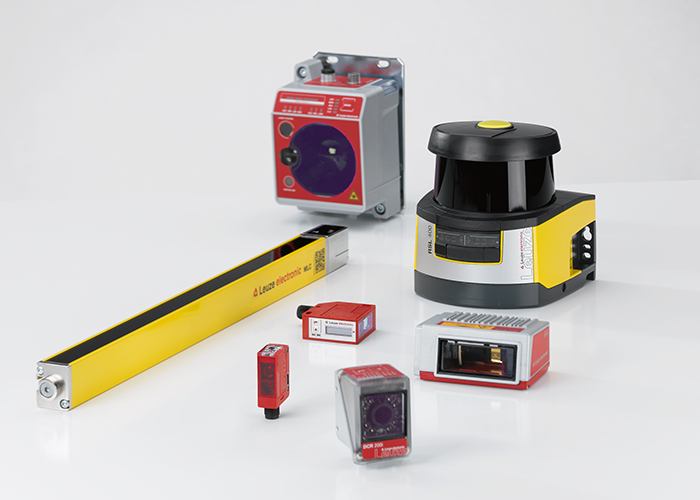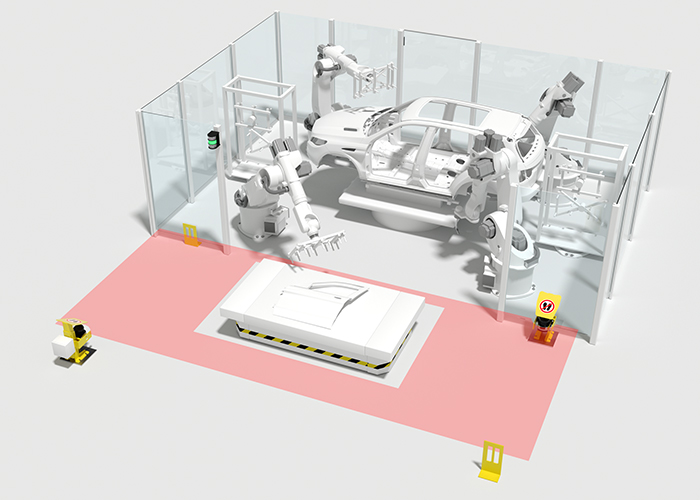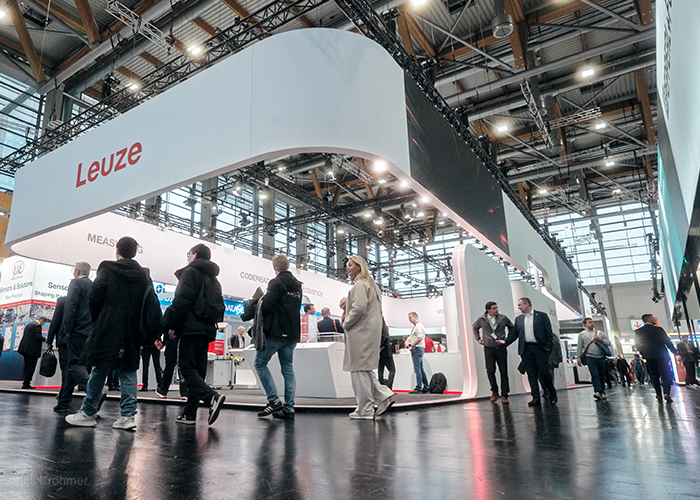Machine safety in the USA
Laws and standards in USA
In 1970, Congress enacted a law entitled the "Occupational Safety and Health Act (OSHA)". Its objective was to reduce the existing dangers to safety and health at the workplace and continuously improve the occupational health and safety regulations already in place. The Occupational Safety and Health Administration (OSHA) was set up as the responsible supervisory authority.
The following information provides an overview of the essential US American body of rules and regulations and standards in the machine safety area and in no way does it replace the required intensive study of the respective documents. It neither raises objection to completeness nor allows any legal claim to be derived from it. The respective currently applicable regional specifications or machine-specific standards must be observed.
OSHA Verordnungen
Im U.S. Code of Federal Regulations, Title 29, Part 1910, Subpart 0, sind allgemeine und maschinenspezifische Sicherheitsstandards für Maschinen enthalten. Die nachfolgende Liste zeigt einige Beispiele. Ergänzende Informationen sind unter www.osha.gov zu finden.
Auszug aus U.S. Code of Federal Regulations, Title 29, Part 1910, Subpart 0
| Dokumentennummer | Titel und Inhalt |
| OSHA 1910.211 | Definition |
| OSHA 1910.212 | Allgemeine Anforderungen für alle Maschinen |
| OSHA 1910.213 | Anforderungen an Holzbearbeitungsmaschinen |
| OSHA 1910.214 | Anforderungen an Küfereimaschinen |
| OSHA 1910.215 | Anforderungen an Schleifmaschinen |
| OSHA 1910.216 | Anforderungen an Mühlen und Kalander in der gummi- und kunststoffverarbeitenden Industrie |
| OSHA 1910.217 |
Mechanische Pressen |
| OSHA 1910.218 | Schmiedemaschinen |
| OSHA 1910.219 | Mechanische Kraftübertragungsmaschinen |
In den USA existiert keine einheitliche Bundesgesetzgebung, welche die Verantwortlichkeit des Herstellers bzw. Lieferanten regelt. Die US-Bundesstaaten sind jedoch durch OSHA, 1970, Sektion 18 aufgefordert, eigene Arbeitssicherheits- und Gesundheitsprogramme zu entwickeln. Für jedes dieser Programme stellt OSHA auf den Websites www.osha.gov oder www.osha-slc.gov zusätzliche Informationen bereit.
US-Normen ANSI, NFPA, UL (National Consensus Standards)
Zusätzlich zu den OSHA-Standards ist die Behörde OSHA ermächtigt, die Einhaltung von National Consensus Standards zu überwachen und zu erzwingen. Dies sind Normen, Arbeitssicherheits- oder Gesundheitsbestimmungen oder Modifikationen solcher, die
- von einer national anerkannten Normen-setzenden Organisation (z. B. ANSI, UL) verabschiedet und verbreitet wurden
- vom Arbeitsministerium (Secretary of Labor) als Norm gekennzeichnet sind
- in Form von internationalen Normen (IEC, ISO) Themen oder Fachgebiete behandeln, welche nicht von einer amerikanischen Norm abgedeckt sind.
U.S. National Consensus Standards sind also Normen, die ergänzend zu den OSHA Standards gelten. Nachfolgend sind einige solcher Normen gebenden Körperschaften genannt:
- American National Standards Institute (ANSI) www.ansi.org
- National Fire Protection Agency (NFPA) www.nfpa.org
Auswahl wichtiger U.S. National Consensus Standards im Bereich Maschinensicherheit:
| Standard | Titel und Inhalt |
| ANSI B11.1 | Mechanicacl Power Presses - Safety Requirements for Construction, Care, Use |
| ANSI B11.2 | Hydraulic Power Presses - Safety Requirements for Construction, Care, Use |
| ANSI B11.3 | Power Press Brakes - Safety Requirements for Construction, Care, Use |
| ANSI B11.4 | Machine Tools - Schears - Safety Requirements for Construction, Care, Use |
| ANSI B11.5 | Machine Tools - Iron Workers - Safety Requirements for Construction, Care, Use |
| ANSI B11.6 | Lathes - Safety Requirements for Construction, Care and Use |
| ANSI B11.7 | Cold Headers and Cold Formers - Safety Requirements for Construction, Care and Use |
| ANSI B11.8 | Drilling, Mining and Boring Machines - Safety Requirements for Construction, Care and Use |
| ANSI B11.9 | Grinding Machines - Safety Requirements for Construction, Care and Use |
| ANSI B11.10 | Metal Sawing Machines - Safety Requirements for Construction, Care, Use |
| ANSI B11.11 | Gear-Cutting Machines - Safety Requirements for Construction, Care, Use |
| ANSI B11.12 | Machine Tools - Roll-Forming and Roll-Bending Machines - Safety Requirements for Construction, Care and Use |
| ANSI B11.13 | Machine Tools - Single- and Multiple-Spindle Automatic Bar and Chucking Machines - Safety Requirements for Construction, Care and Use |
| ANSI B11.14 | Machine Tools - Coile-Slitting Machines - Safety Requirements for Construction, Care and Use |
| ANSI B11.15 | Pipe, Tube and Shape-Bending Machines - Safety Requirements for Construction, Care and Use |
| ANSI B11.16 | Metal Powder Compacting Presses - Safety Requirements for Construction, Care and Use |
| ANSI B11.17 | Machine Tools - Horizontal Hydraulic Extrusion Presses - Safety Requirements for Construction, Care and Use |
| ANSI B11.18 | Machine Tools - Machines and Machinery Systems for Processing Strip, Sheet or Plate from Coiled Configuration - Safety Requirements for Construction, Care and Use |
| ANSI B11.19 | Performed Criteria for the Design, Construction, Care and Operation of Safeguarding when referenced by other B11 Machine Tool Safety Standards |
| ANSI B11.20 | Machine Tools - Manufacturing Systems / Cells - Safety Requirements for Construction, Care and Use |
| ANSI B11.21 | Machine Tools - Using Lasers for Processing Materials - Safety Requirements for Construction, Care and Use |
| ANSI B11.TR1 | Ergonomic Guidelines for Design, Installation and Use of Machine Tools |
| ANSI B11.TR2 | Mist Control on Machines Using Metal Working Fluids |
| ANSI B151.27 | Safety Requirements for Robots Used with Horizontal Injection Molding Machines |
| ANSI B56.5 | Safety Standards for Guided Industrial Vehicles and Automated Functions of Manned Industrial Vehicles |
| ANSI R15.06 | Safety Requirements for Robots and Robot Systems |
| ANSI B65.1 | Safety Standards for Printing Press Systems |
| NFPA 70E | Electric Safety Requirements for Employee Workplaces |
| NFPA 79 | Electrical Standard for Industrial Machinery |
| UL 508 | Industrial Control Equipment |
| UL 61496-1 | Electro-Sensitive Protective Equipment, Part 1: General Requirements for Design, Construction and Testing of Electrosensitive Protective Devices (ESPDs). |
| UL 61496-2 | Electro-Sensitive Protective Equipment, Part 2: Particular Requirements for Equipment Using Active Opto-Electronic Protective Devices (AOPDs). |
Strategie zur Risikoreduzierung
Im U.S. Code of Federal Regulations, Title 29, Part 1910, Subpart 0 ist sinngemäß gefordert, dass beim Konstruieren der Maschine die möglichen Risiken zu analysieren sind und, wo erforderlich, zusätzliche Schutzeinrichtungen zum Schutz des Bedieners vorzusehen sind.
Der Technical Report ANSI B11.TR3:2000 enthält Vorschläge zur Einschätzung, Bewertung und Reduzierung von Risiken an Werkzeugmaschinen.
OSHA/ANSI sieht folgende hierarchische Vorgehensweise zur Risikoreduzierung vor:
- Identifiziere und analysiere das Risiko (siehe ANSI B11.TR3:2000)
- Beseitige das Risiko durch konstruktive Maßnahmen
- Reduziere das Risiko durch technische Schutzeinrichtungen
- Warnsignale und Warnhinweise
- Persönliche Schutzausrüstung für das Bedienpersonal
- Training des Bedienpersonals
Die internationale Norm ISO 12100 "Sicherheit von Maschinen - Allgemeine Gestaltungsleitsätze - Risikobeurteilung und Risikominderung" ist ähnlich strukturiert. Sie gibt detaillierte Hilfestellung bei der Identifizierung von Gefährdungen, beschreibt die vom Konstrukteur zu betrachtenden Risiken, enthält Gestaltungsleitsätze und eine Methode zur sicheren Konstruktion und Risikominderung. Sie beschreibt außerdem eine iterative Methode zur Risikoanalyse, Risikobeurteilung und Risikominderung zum Erreichen der erforderlichen Maschinensicherheit. Bestehende maschinenspezifische Normen, wie z. B. Typ-C EN Normen, sind vorrangig zu beachten.
Zuverlässigkeit von Steuerungen (Control Reliability)
OSHA 1910.211
Enthält sinngemäß die folgenden Anforderungen: Ein Steuerungssystem muss so konstruiert sein, dass
- ein innerhalb des Systems auftretender Fehler das Auslösen des normalen Stoppvorgangs nicht verhindert,
- ein weiterer Maschinenzyklus nicht ausgeführt werden kann, bevor der Fehler nicht behoben ist und
- der Fehler durch einen einfachen Test aufgedeckt, oder vom Steuerungssystem angezeigt werden kann.
ANSI B11.19-2003
Abschnitt 3.14 definiert Control Reliability sinngemäß wie folgt:
Control Reliability ist die Fähigkeit der Maschinensteuerung, der Schutzeinrichtung, anderer Steuerungskomponenten und der damit verbundenen Schnittstellen, einen sicheren Zustand herbei zu führen wenn ein Fehler auftritt, der ihre sicherheitsbezogene Funktionen betrifft.
Abschnitt E.6.1 präzisiert weiter:
Kann die wiederholte Ausführung eines Maschinenzyklus
- beim Auftreten eines schweren mechanischen Fehlers oder
- bei gleichzeitigem Ausfall von mehreren Komponenten nicht verhindern.
Zum strukturellen Aufbau gibt die Norm folgenden Hinweis:
Control Reliability wird nicht durch einfache Redundanz gewährleistet. Es muss eine Überwachung stattfinden um sicherzustellen, dass die Redundanz wirksam bleibt.
ANSI B11.20
Auch in der ANSI B11.20, Abschnitt E.6.13, wird zur Steuerungsstruktur sinngemäß folgendes ausgesagt:
Schutz vor den Folgen des Ausfalls von Steuerungskomponenten sollte nicht allein von einfacher Redundanz abhängen. Ein Ausfall einer Komponente von zwei oder mehreren parallel oder seriell geschalteten Steuerungskomponenten kann bei einfacher, also nicht überwachter Redundanz, unbemerkt bleiben. Der Anschein eines sicheren Betriebs bleibt erhalten. Wenn nun in der Folge ein weiteres Element im anderen, redundanten Schaltkreis ebenfalls ausfällt, kann ein gefahrbringender Zustand eintreten. Eine Überwachung von redundanten Steuerungsstrukturen und die Aufdeckung und die sichere Reaktion auf solche Einzelfehler ist daher zwingend erforderlich.
ANSI / RIA R15.06-1999
Diese ANSI-Norm enthält weitere funktionale Anforderungen zur Control Reliability und auch Aussagen zu Fehlern aufgrund gemeinsamer Ursachen, wie z. B. Überspannung. Anmerkung: Der Begriff „gemeinsam“ bedeutet, dass diese Ursachen gleichzeitig und in gleicher Weise auf die redundant aufgebauten Steuerungskanäle einwirken können.
- Die Überwachung muss ein Stoppsignal auslösen, wenn ein Fehler erkannt wird
- Es muss eine Warnung ausgegeben werden, wenn die Gefährdung weiter bestehen bleibt, nachdem die Bewegung zum Stillstand gekommen ist.
- Nachdem der Fehler erkannt wurde, muss ein sicherer Zustand aufrecht erhalten bleiben, bis der Fehler behoben ist.
- Fehler mit gemeinsamer Ursache (z. B. Überspannung) müssen berücksichtigt werden, wenn die Wahrscheinlichkeit des Auftretens eines solchen Fehlers hoch ist.
- Ein Einzelfehler sollte zum Zeitpunkts seines Auftretens erkannt werden. Wenn dies nicht praktikabel ist, sollte der Fehler bei der nächsten Inanspruchnahme der Sicherheitsfunktion erkannt werden.
Vergleich der ANSI, IEC/EN-Anforderungen an sicherheitsgerichtete Steuerungen
Es existiert keine exakte Übereinstimmung in der Definition von Funktionaler Sicherheit oder Control Reliability in der US- und IEC/EN-Normenwelt. Relativ nahe an die OSHA/ ANSI Anforderungen kommen die Anforderungen der Kategorie 3 der ISO 13849-1:
- Die sicherheitsbezogenen Teile von Steuerungen und/oder ihre Schutzeinrichtungen als auch ihre Bauteile müssen in Übereinstimmung mit den zutreffenden Normen so gestaltet, gebaut, ausgewählt und kombiniert werden, dass sie den zu erwartenden Einflüssen standhalten können.
- Bewährte Sicherheitsprinzipien müssen bei der Konstruktion angewendet werden. Sicherheitsbezogene Teile müssen so gestaltet sein, dass:
- ein einzelner Fehler in jedem dieser Teile nicht zum Verlust der Sicherheitsfunktion führt, und
- wann immer in angemessener Weise durchführbar, der einzelne Fehler erkannt wird
Das Verhalten im Fehlerfall einer sicherheitsgerichteten Steuerung nach Kategorie 3 wird wie folgt spezifiziert:
- Wenn ein einzelner Fehler auftritt, bleibt die Sicherheitsfunktion immer erhalten.
- Einige, aber nicht alle Fehler werden erkannt.*
- Eine Anhäufung unerkannter Fehler kann zum Verlust der Sicherheitsfunktion führen.*
*) Die Risikobewertung gibt an, ob der volle oder teilweise Verlust der Sicherheitsfunktion(en), der sich aus den Fehlern ergibt, tragbar ist.
Hinweis
Die PC-Software SISTEMA des Instituts für Arbeitsschutz (IFA) dient zur Berechnung und Bewertung der funktionalen Sicherheit von Steuerungssystemen gemäß ISO 13849-1. Sie ist als Freeware kostenlos unter www.dguv.de/ifa/praxishilfen verfügbar.






